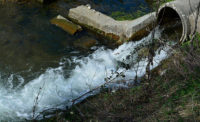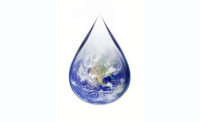This spring, a Cargill pork plant in Ottumwa, Iowa, accidently released 20,000 gallons of untreated wastewater (because of a control panel malfunction) into the Des Moines River until a backup pump began operating.
Wastewater generally doesn’t make the consumer headline news for good reasons. However, many meat and poultry processors are testing and using the latest water-treatment technologies, and eliminating chemicals such as nitrogen and phosphorus that may face heavier regulations soon.
Processors generally send wastewater to municipal wastewater treatment locations, where the strength of the wastewater is measured in pH; Total Suspended Solids (TSS); Biological Oxygen Demand (BOD); and Fats, Oils and Greases (FOG). But they can also use septic systems, constructed wetlands, anaerobic digesters or pond or lagoon systems, notes the Niche Meat Processor Assistance Network (NMPAN).
Improving wastewater pre-treatment efficiency and maintaining operationally excellent pre-treatment processes is the key to minimizing overall costs.
“Basically, the better the system operates, the better the results,” says Scott Hartter, vice president of environment, health and safety at Cargill, in Wichita, Kansas. “With more and more scrutiny on nitrogen and phosphorus discharge, additional technology such as chemical pretreatment systems in DAF [dissolved air flotation] operations can also significantly reduce the nitrogen and phosphorus on the front end, as opposed to costly tertiary [additional biological] treatment additions on the back end.”
The most effective way to manage wastewater is to not generate it. Barring that circumstance, processors can provide treatment processes that are efficient, well maintained and proactively managed, whether they are in a direct or indirect discharge situation.
“We work closely with our municipal partners on wastewater programs, ensuring that a proper treatment balance is in place to meet water quality goals as efficiently as possible,” says Tom E. Raymond, Hormel’s director of environmental sustainability, in Austin, Minn.
Also, he notes that shining a light on water conservation and reuse has a direct and positive impact on wastewater management.
“When wastewater is generated, our first thought is for use in offsetting fresh-water needs,” says Raymond. “For instance, at some of our locations, water from wastewater treatment systems is used to irrigate surrounding cropland. When managed properly, approaches like this can effectively reduce fresh-water demand.”
Moreover, “we also need to encourage a new view of wastewater, in that it is not a ‘waste’ material,” he says. On the far end of that spectrum of perception sit the cities of Wichita Falls and Big Spring, Texas, for example. Those two municipalities have launched “toilet-to-tap” programs, through which cleaned toilet water is reused as drinking water, in response to severe water shortages.
Sanderson Farms is focused on employing consistent technologies and efforts in all of its nine plants, says Bob Billingsley, director of development, procurement and engineering, Sanderson Farms Inc., based in Laurel, Miss.
“When we build a new plant, we look at what technology will take us past where we are today to the next phase,” he says. “Then we take that technology and apply it to our old facilities.”
Also, Billingsley notes, it is better to take out solids when they are upstream, not when they get to the wastewater treatment plant.
“Every pound of organics that can be taken out earlier helps the system work more efficiently,” he says.
Dissolving solids
Total dissolved solids are always difficult to remove because there is no easy way to treat dissolved solids once they are absorbed by the wastewater, says Hartter.
“Ensuring very good practices around hide curing, pickling operations and chemical usage are key,” says Hartter. “The majority of dissolved solids that pose our greatest challenge are sodium-based or chloride-based.”
Cargill has modified some of its chemical usage to include more that contain lower levels of dissolved solids.
“We understand the importance of properly managing natural resources that enable us to feed a hungry world, including the use of water,” he says.
Nutrient limits are also providing challenges in the industry. Phosphorus and nitrogen are under review, because they are the main nutrients in wastewater, encouraging the growth of organic matter and algae that causes eutrophication — changing the ecosystem — in water bodies.
Raymond notes that adapting to a changing water supply, both in terms of availability and quality, is also an ongoing challenge, which is heightened when the cost of water has not risen in proportion to the water-supply concerns.
“Technology to address these challenges is available in many cases, but the technology often means high capital and operating costs that create a difficult financial hurdle,” Raymond says. “The key is to continue to drive engagement and explore innovative solutions with internal and external stakeholders.”
Reducing water footprint
Companies can certainly reduce their water footprint by reusing as much water as possible.
According to Hartter, Cargill’s North American meat businesses have reduced their water use by 15 percent since 2001.
One way is by increasing partnerships with local farmers to increase irrigation use of its treated wastewater and decrease the discharge to waterways.
“In some cases, as receiving waterways become more stressed or even nonexistent [dry up] we have expanded our ability to use all of our wastewater for irrigation rather than only during the dry season,” says Hartter. “This may require expanding storage capability, but is generally a win-win, as it reduces the amount of water withdrawn from the local aquifer.”
Historically, Hormel has used a blended approach of engineered solutions and administrative controls to control its water footprint, notes Raymond. “Fostering employee awareness and engagement is a critical component to the success of our sustainability programs,” he says.
In fact, Raymond says recognizing the nexus between water, wastewater and energy programs helps identify multiple areas of cost control and efficiency improvement.
“A great example of this is our use of closed-loop cooling systems to reduce fresh-water use and recover useful heat,” he says. “The benefits to our water and energy programs are clear, but we certainly see benefits to wastewater treatment systems by reducing the hydraulic loading.”
Trading post
Companies are also looking into ways to form renewable energy from the wastewater process.
“Saving energy saves costs,” says Sybil Sharvelle, Ph.D., associate professor, Department of Civil and Environmental Engineering, Colorado State University, Fort Collins, Colo.
She notes processors are also retrofitting pumps, improving air filtration so it’s an energy-efficient system and employing aeration.
“With wastewater, plants recover energy with anaerobic digestion, as well,” she says.
Anaerobic digestion is a biological process in which the process of treating wastewater and waste generates electricity, although the NMPAN notes it’s too expensive for smaller processors.
The process creates a biogas (of methane, carbon dioxide and other contaminant gases) that can be used as fuel, biomethane or fertilizer.
“It’s commonly used with generators to fuel aeration systems,” says Sharvelle, and will be used more in the future.
Going forward, many states are creating more stringent nutrient removal standards, which affect which nutrients may be released from wastewater facilities.
Nitrogen and phosphorus limits are the most commonly discussed, so many processors are upgrading their facilities now to accommodate this predicted change.
“In Colorado, the Environmental Protection Agency is trying to reduce nitrogen and phosphorus loads in the next three to four years, which are easy to pinpoint at facilities,” says Sharvelle.
Nutrient trading between sectors could be a future option, she says. A nutrient trading market has the same theory as carbon credits: Companies that reduce their nutrient discharges can sell their “credits” to other sources to help them reach pollution targets in a cost-effective manner.
“We are looking at trading between municipal stormwater programs and agriculture, for example,” says Sharvelle.
Regulating wastewater
A company like West Liberty Foods (WLF) can process 22,000 birds a day, so how do local wastewater treatment plants clean such a high volume of wastewater?
The government of West Liberty, Iowa, for one, contracts water treatment to CH2M HILL, a global engineering firm.
According to Dave Clark, area manager, CH2M HILL, West Liberty Foods’ water goes through a chemical pre-treatment (and heavier solids are floated to the surface) with polymer and chloride before it reaches CH2M HILL’s facility.
Once there, the water is tested to see if it is in compliance with state and federal ordinances. If it is not, then the company can be fined, although that is usually a last resort.
The wastewater plant then uses the extended aeration sludge process, which is a form of activated sludge process.
“West Liberty Foods’ process is chemical whereas ours is biological,” he says.
He notes his company meets quarterly with WLF to discuss issues based on their discharges.
“It’s important that the industry thinks of the regulators as partners, not adversaries,” he says. “We work more as a team, because it’s better for the city to correct issues jointly than just issue fines.”
Because Cooper Farms in Van Wert, Ohio, is outside city limits, it has a permit from the Ohio Environmental Protection Agency instead to work as a direct discharger following the National Pollution Discharge Elimination System, says Tracy McPheron, superintendant for Van Wert’s Wastewater Treatment Plant.
“When I work with a food company, it will treat its water to a level I can handle, and then I treat it further,” he says, noting Carbonaceous Biochemical Oxygen Demand (CBDOD) can only be 216 milligrams per liter and TSS is 250 milligrams per liter.
In Van Wert, the wastewater limits are set by a city waste ordinance. If the waste materials are above the limit, the city issues a surcharge for a certain amount per pound above the limit.
The wastewater treatment plant uses activated sludge technology to clean its water, says McPherson. He says Delphos, Ohio’s, wastewater treatment plant uses membrane filtration, which is a cutting-edge technology, but also could have operational challenges.
“All of these processes are designed by a professional engineer, submitted to the EPA and then approved,” he says. “Membrane filtration, for example, provides good treatment, but the maintenance, durability and costs will only be known with time.”






Report Abusive Comment